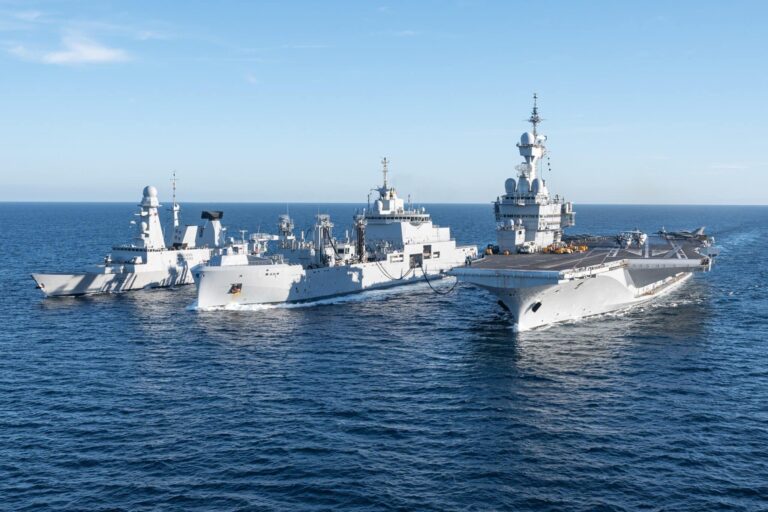The French Navy’s Carrier Strike Group has officially returned to home waters following a substantial five-month deployment that underscored France’s ongoing commitment to global maritime security and NATO operations. The mission, which involved joint exercises and strategic partnerships across various theaters, included vital collaborations with allied forces and demonstrated the group’s versatility and readiness. As global tensions continue to evolve, the strike group’s return highlights not only the operational capabilities of the French military but also its role in reinforcing international alliances amid a dynamic geopolitical landscape. This article delves into the details of the deployment, its objectives, and the implications for France’s naval strategy moving forward.
Deployment Overview and Operational Achievements of the French Carrier Strike Group
The return of the French Carrier Strike Group marks a significant milestone in maritime operations, showcasing advanced naval capabilities and strategic partnerships. Over the five-month deployment in key regions, the fleet has accomplished a series of essential tasks that underscore its operational readiness and effectiveness. The deployment entailed:
- Joint Exercises: Conducted multinational training drills with allied navies, enhancing interoperability.
- Humanitarian Assistance: Engaged in relief operations in response to regional crises, strengthening diplomatic ties.
- Surveillance Missions: Monitored maritime security threats, ensuring safe navigation in international waters.
Throughout this deployment, the French Carrier Strike Group not only demonstrated formidable offensive capabilities but also reinforced global maritime stability. Notable operational achievements included:
| Operation | Outcome |
|---|---|
| Anti-piracy Patrols | Successful deterrence of piracy incidents off the Horn of Africa |
| Maritime Security Operations | Enhanced safety for commercial shipping routes in the Mediterranean |
| Exercise Pegasus | Strengthened collaboration with NATO allies |
Strategic Implications for NATO and European Defense Posture
The successful return of the French Carrier Strike Group after a five-month deployment underscores significant shifts in NATO’s operational dynamics and European defense strategies. As NATO continues to adapt to evolving security challenges, this operation not only reaffirms France’s commitment to collective defense but also strengthens inter-allied cooperation. The deployment served as a critical demonstration of naval capabilities, enhancing joint training exercises with allied forces, particularly in the Mediterranean and beyond. NATO’s focus on power projection and maritime security is increasingly essential as it faces threats ranging from terrorism to geopolitical tensions with major powers.
Key elements to consider in light of this deployment include:
- Enhanced Naval Readiness: The presence of a French carrier strike group provides a stabilizing maritime force that contributes to NATO’s rapid response capabilities.
- Interoperability: Joint drills with various NATO forces signify a growing emphasis on seamless operational integration, crucial for collective defense strategies.
- Force Multiplication: The integration of advanced French naval assets bolsters European infrastructure and military readiness across the continent.
To encapsulate the strategic shifts facilitated by this deployment, the following table illustrates key operational benefits anticipated from the French Carrier Strike Group’s mission:
| Operational Benefit | Description |
|---|---|
| Increased Deterrence | Heightened presence in key areas discourages potential aggressors. |
| Joint Operational Experience | Enhanced skills through cooperation with allied fleets. |
| Strategic Positioning | Support for rapid response initiatives in critical regions. |
Lessons Learned: Enhancements in Multi-National Naval Collaboration
The successful five-month deployment of the French Carrier Strike Group has underscored several key enhancements in multi-national naval collaboration. The operation, which involved forces from multiple allied nations, highlighted the importance of shared training and coordinated strategies. Joint exercises, such as air defense and anti-submarine warfare drills, facilitated an unprecedented level of interoperability among participating navies. The lessons learned are invaluable, particularly in the face of emerging global maritime challenges. Key takeaways include:
- Increased Interoperability: Seamless integration of different systems and protocols.
- Enhanced Communication: Real-time data sharing improved decision-making processes.
- Unified Command Structures: Streamlined operational command led to more effective missions.
The deployment also revealed the significant role of forward-deployed naval forces in contributing to regional stability. With ongoing tensions in various maritime domains, the effectiveness of a multi-national approach is clear. The deployment allowed participating nations to foster robust diplomatic ties while enhancing their defensive capabilities. The following table summarizes the key collaborative achievements of the carrier group during this deployment:
| Achievement | Details |
|---|---|
| Joint Air Operations | Conducted 150+ sorties over key regions. |
| Logistical Support | Shared supply chains reduced response times. |
| Training Programs | Executed training for over 500 naval personnel. |
Recommendations for Future Deployments and Interoperability Exercises
As the French Carrier Strike Group concludes its five-month deployment, several key considerations emerge for future naval operations and interoperability exercises. Enhanced integration between allied forces is crucial for maximizing operational effectiveness during joint missions. Training scenarios should emphasize realistic combat situations, enabling personnel to adapt quickly to evolving threats. To achieve this, exercises should prioritize:
- Joint air and maritime tactics
- Real-time communications protocols
- Exchange programs for crew members
Furthermore, the deployment experience highlights the necessity of synchronized logistics and supply chains among NATO allies. A cooperative framework for sharing resources can reduce operational costs and improve mission readiness. Future interoperability exercises should include:
| Focus Area | Importance |
|---|---|
| Logistics Coordination | Streamlines resource allocation |
| Cybersecurity Measures | Protects sensitive information |
| Environmental Protocols | Ensures sustainable practices |
Concluding Remarks
In summary, the return of the French Carrier Strike Group marks a significant milestone not only for the French Navy but also for international maritime operations. After five months of deployment, during which the group conducted vital exercises and reinforced alliances, its homecoming signifies a renewed focus on regional security and defense collaboration. As global naval dynamics continue to evolve, the experiences and lessons learned during this deployment will undoubtedly shape future missions and strategic planning. The ongoing commitment of France to international naval engagements underscores its role as a key player in ensuring stability and security at sea. Moving forward, all eyes will be on how these developments influence both regional geopolitics and multinational naval cooperation in the years to come.




